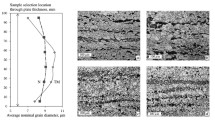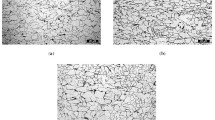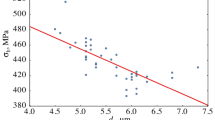Abstract
The article considers the results of studying the influence of the microstructural parameters of Charpy specimens with a sharp stress concentrator and Mesnager specimens with a circular stress concentrator from rolled products of various thicknesses on their impact strength at temperatures from 0 to –80°C with an increment step of 20°C. The used roll products were made from low-carbon microalloyed steel at JSC “Vyksa Steel Works”. The tests were conducted using optical and scanning electron microscopy. It is shown that the thinner metal pieces (6 and 8 mm) have the same chemical composition and are treated in the same thermomechanical modes as their thicker counterparts but have higher strength properties (by 10 MPa on average for temporary resistance and by 30 MPa for yield strength) and a viscosity margin at negative temperatures at close grain score values and average grain size corresponding to numbers 10–11 according to GOST 5639. The lowest level of cold resistance is shown by the metal pieces with a thickness of 12 mm, and their brittle transition temperature is -50°C. The structure of the rolled products of various thicknesses exhibits variations in grain size. The thinner rolled products contain smaller grains corresponding to number 14. The thicker rolled products contain larger grains corresponding to number 8. The electron microscopic examination by the Electron Backscatter Diffraction (EBSD) technique helps find out that the rolled products of 6 and 8 mm in thickness contain more high-angle boundaries, which are barriers for brittle cracking. The constructed orientation maps of microstructure reveal the presence of pronounced strain texture corresponding to orientations 〈110〉 || RD (rolling direction) and (〈113〉…〈112〉) || RD for the rolled products with a thickness of 6 mm.








Similar content being viewed by others
REFERENCES
Efron, L.I., Metallovedenie v “bol’shoi” metallurgii. Trubnye stali (Metal Science in “Great” Metallurgy. Pipe Steels), Moscow: Metallurgizdat, 2012.
Kislitsa, V.V., Lamukhin, A.M., Isaev, O.B., et al., Foundry and rolling complex: new technologies in the production of rolled products for pipe purposes, Chern. Metall., Byull. Nauchno-Tekh. Ekon. Inf., 2013, no. 4, pp. 50–56.
Naumenko, V.V., Bagmet, O.A., Matrosov, M.Yu., Muntin, A.V., Kichkina, A.A., and D’yakonov, D.L., The influence of a microalloying system on the structure of a coiled strip produced under conditions of endless strip production, Steel Transl., 2020, vol. 50, no. 7, pp. 501–508. https://doi.org/10.3103/S0967091220070104
Naumenko, V.V., Bagmet, O.A., and Mursenkov, E.S., Assimilation of production under casting and rolling conditions of pipe rolled product from steels of the V–N microalloying system resistant to cold and hydrogen sulfide cracking, Metallurgist, 2019, vol. 63, nos. 1–2, pp. 163–175. https://doi.org/10.1007/s11015-019-00806-x
Lamukhin, A.M. and Dubinin, I.V., Startup of a casting-rolling complex and mastery of the production of high-quality rolled products for electric-welded pipes, Metallurgist, 2020, vol. 54, nos. 1–2, pp. 19–27. https://doi.org/10.1007/s11015-010-9268-3
Chervonnyi, A.V., Ringinen, D.A., Chastukhin, A.V., Efron, L.I., Muntin, A.V., Naumenko, V.V., and Bagmet, O.A., Structure and property formation for pipe coiled rolled product during manufacture under casting and rolling complex conditions, Metallurgist, 2019, vol. 62, nos. 9–10, pp. 1012–1021. https://doi.org/10.1007/s11015-019-00748-4
Schwinn, V., Schuetz, W., Fluess, P., and Bauer, J., Prospects and state of the art of TMCP steel plates for structural and linepipe applications, Mater. Sci. Forum, 2007, vols. 539–543, part 5, pp. 4726–4731. https://doi.org/10.4028/www.scientific.net/MSF.539-543.4726
Hara, T., Shinohara, Y., Terada, Y., Asahi, H., and Doi, N., Metallurgical design and development of high deformable high strength line pipe suitable for strain-based design, Proc. Int. Offshore and Polar Engineering Conf., Osaka, Japan, June 21–26, 2009, Osaka, 2009, pp. 73-79.
DeArdo, A.J., Fundamental metallurgy of niobium in steel. Development and production of high strength pipeline steels, Proc. Int. Symp. Niobium 2001, Orlando, USA, December 2–5, 2001, Bridgeville, PA: Niobium-2001, 2001, pp. 427-500.
DeArdo, A.J., Producing high quality niobium-bearing steels using the CSP process at Nucor steel Berkeley, Proc. 5th Int. Conf. HSLA Steels 2005, Sanya, Hainan, China, November 8–10, 2005, Hainan, 2005, vol. 40, pp. 23–29.
Hillenbrand, H., Gras, M., and Kalwa, C., Development and production of high strength pipeline steels, Proc. Int. Symp. Niobium 2001, Orlando, USA, December 2–5, 2001, Bridgeville, PA: Niobium-2001, 2001, pp. 543-569.
Schwinn, V., Fluess, P., and Bauer, J., Production and progress of plates for pipes strength level of X80 and above, Proc. Pipe Dreamers Conf., Yokohama, 2002, pp. 98–114.
Windhager, M., Kneissl, A., and Jeglitsch, F., Evolution of microstructure during the thermomechanical processing of HSLA steels, Proc. Int. Symp. on Processing, Microstructure and properties of HSLA Steels, November 3–5, 1987, Pittsburgh, PA, 1987, pp. 105-116.
Zhang, X., Yang, C., and Shang, C., New development of HSLA steels in China, in HSLA Steels 2015, Microalloying 2015 & Offshore Engineering Steels 2015, Cham: Springer-Verlag, 2015, pp. 3–15. https://doi.org/10.1002/9781119223399.ch1
Yang, C., R&D application of V-N microalloyed steels in China, in HSLA Steels 2015, Microalloying 2015 & Offshore Engineering Steels 2015, Cham: Springer-Verlag, 2015, pp. 917–930. https://doi.org/10.1002/9781119223399.ch115
Bagmet, O.A., Naumenko, V.V., and Smetanin, K.S., A study of the cold resistance of coiled stock for pipes produced at foundry rolling works. Part 1, Met. Sci. Heat Treat., 2018, vol. 59, nos. 9–10, pp. 551–555. https://doi.org/10.1007/s11041-018-0188-3
Kolbasnikov, N.G., Zotov, O.G., Shamshurin, A.I., and Luk’yanov, A.A., Study of lath morphology bainite in high-strength pipe steel, Met. Sci. Heat Treat., 2013, vol. 55, nos. 5–6, pp. 287–293. https://doi.org/10.1007/s11041-013-9621-9
Lobanov, M.L., Yurovskikh, A.S., Kardonina, N.I., et al., Metody issledovaniya tekstur v materialakh (Study Methods of Textures in Materials), Yekaterinburg: Ural. Fed. Univ., 2014.
Umanskii, Ya.S., Kristallografiya, rentgenografiya i elektronnaya mikroskopiya (Crystallography, Radiography, and Electron Microscopy), Moscow: Metallurgiya, 1982.
Platov, S.I., Krasnov, M.L., Urtsev, N.V., Danilov, S.V., and Lobanov, M.L., Structural and textural states of steel 06G2MB strips after controlled thermomechanical treatment, Met. Sci. Heat Treat., 2020, vol. 62, nos. 1–2, pp. 55–60. https://doi.org/10.1007/s11041-020-00512-5
Joo, M.S., Suh, D.W., Bae, J.H., and Bhadeshia, H.K.D.H., Role of deamination and crystallography on anisotropy of Charpy toughness in API-X80 steel, Mater. Sci. Eng., A, 2012, vol. 546, pp. 314–322. https://doi.org/10.1016/j.msea.2012.03.079
Haskel, H.L., Pauletti, E., Martins, J.P., and Carvalho, A.L.M., Microstructure and microtexture assessment of delamination phenomena in Charpy impact tested specimens, Mater. Res., 2014, vol. 17, no. 5, pp. 1238–1250. https://doi.org/10.1590/1516-1439.268314
Misra, R.D.K., Nathahi, H., Siciliano, F., and Carneiro, T., Effect of texture and microtexture on resistance to cracking of high-strength hot-rolled Nb–Ti micro-alloyed steels, Metall. Mater. Trans. A, 2004, vol. 35, pp. 3024–3029.
Author information
Authors and Affiliations
Corresponding authors
Additional information
Translated by S. Kuznetsov
About this article
Cite this article
Naumenko, V.V., Smetanin, K.S., Muntin, A.V. et al. Formation Features of the Structure and Mechanical Properties in Rolled Products with Various Thicknesses from Low-Carbon Microalloyed Steel Produced at an Integrated Casting and Rolling Facility. Steel Transl. 51, 607–615 (2021). https://doi.org/10.3103/S0967091221090096
Received:
Revised:
Accepted:
Published:
Issue Date:
DOI: https://doi.org/10.3103/S0967091221090096




